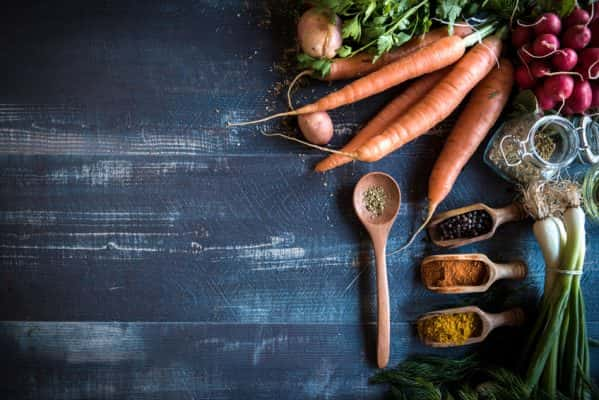
Cooking concept with vegetables and copy space in the middle on wooden background
MAGICAL MUSHROOMS
(The edible ones)
John Ash (c) 2020
Mushrooms are one of the most interesting foods that we consume. Delicious, deadly, mysterious, intoxicating, enigmatic. Throughout history mushrooms have varying reputations, considered both food and foe. Today it is easy to find safe, delicious mushrooms in the market, but it wasn’t always that way. In the past reckless wild mushroom hunters threw caution to the wind with sometimes fatal results, often giving culinary mushrooms a bad reputation.
Mushrooms were long considered part of the plant kingdom. It wasn’t until the mid-20th century that they were recognized as belonging to their own kingdom: Fungus (plural Fungi) and distinct from plants or animals. Fungi are among the most widely distributed organisms on Earth and are of great environmental and medical importance. Many are free-living in soil or water; others form parasitic or symbiotic relationships with plants or animals. Fungus contains more than 144,000 known species which includes yeasts, rusts, smuts, mildews, molds and our interest here – – mushrooms of which there are reportedly at least 38,000 species.
We are lucky in Sonoma county because we have access to a wide range of both cultivated and wild culinary mushrooms. Re the latter be cautious of course. Many wild mushrooms are poisonous and can be life-threatening. Best to buy your wild mushrooms from a reputable grower or grocer than hunting them yourself. If however, after that warning, you are still interested in foraging mushrooms yourself, the Sonoma County Mycological Society www.somamushrooms.org is the place to start. They offer classes and forays including their SOMA Wild Mushroom Camp in January which is taught by very knowledgeable foragers including the legendary David Arora: www.davidarora.com who has written two of the most important field guides for wild mushrooms and is a real hoot!
Up until the last few years mushrooms were considered nutritionally “deficient”. We know now that this is not the case. They are one of those “super foods” (stand aside blueberries!). Mushrooms are one of the few natural sources of vitamin D, which is essential for healthy bones and teeth. They are also a great source for B-vitamins, Riboflavin (B 2) which helps maintain healthy red blood cells plus Niacin, Pantothenic Acid (which plays a number of metabolic roles) as well as Biotin and Folate (which we know is important for pregnant women). Mushrooms are one of the richest, natural sources of selenium, an essential mineral which strengthens the immune system and may help reduce the risk of cancer and other chronic illnesses. Mushrooms are also a good source of zinc, another essential mineral which helps boost your immune system as well as your libido! A 100g serving of mushrooms contains more dietary fiber (2.5g) than 100g of celery (1.8g) or a slice of whole-wheat bread (2.0g).
Our own Gourmet Mushrooms in Sebastopol www.mycopia.com, who cultivate several exotic culinary mushrooms, also make and sell what they call “ Mycobiotic Nutraceuticals” which have many healthful properties including reportedly significantly boosting the immune system.
A few interesting mushroom facts to impress friends with:
⦁ The largest living organism on earth is a mushroom. Forget Blue Whales! Next time you purchase button mushrooms at the market remember they have a relative that occupies some 2,300 plus acres of soil in Oregon’s Blue Mountains. This humongous fungus would encompass more than 1700 football fields, or nearly four-square miles of turf. Based on its current growth rate, it’s estimated to be 2,400 years old but could be as ancient as 8,650 years, which would earn it a place among the oldest living organisms as well.
⦁ Portabella mushrooms, button mushrooms both white and brown (cremini) are all the same mushroom at different levels of maturity.
⦁ The Japanese have confirmed that lightning strikes can more than double some mushroom crops, both in the wild and in cultivation. They have successful ongoing experiments that are jolting fungi with electricity to increase yields.
Cleaning Mushrooms:
The conventional wisdom is that mushrooms are very porous, and you shouldn’t expose them to water because it will make them soggy. We were told to wipe them off with a damp towel or worse yet buy a mushroom brush to clean them up. It’s what I was taught by me by my Grandmother and Culinary School. Ain’t so however and it takes forever.
Best way to clean mushrooms is with a brisk shower of water in a colander to wash off any compost (if cultivated) or dirt (if wild). Don’t let them soak of course. They will absorb negligible water and still sauté or roast nicely. With wild mushrooms, which can be a little dirty or soggy if gathered after a rain, after washing place them uncovered in a single layer on a baking sheet in the refrigerator for a day or two which will dry them out. Remember that refrigerators work to remove moisture that is naturally present in the air inside of the unit.
Storing Mushrooms:
Weird to think but mushrooms are still alive and transpiring when we acquire them. Under no circumstances put them in a plastic bag which will suffocate them and eventually make them slimy, mildewed and not delicious. Best to store in a brown paper bag in the fridge until ready to use. It’s OK if they dry out a bit.


